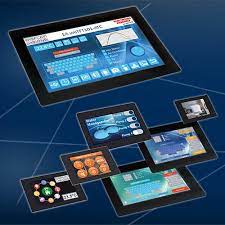LCD Display Monitors
Active Products Parts:
- DC/DC Converters
- LCD Pannels/Monitors
- Memory
- Opto-electronics
- Semiconductors
- Surge Arresters
IBS Electronics distributes a complete line of standard character and graphic LCD modules, including TFT color LCD modules. We supply a wide variety of available options, including wide viewing angle, extended temperature range, backlighting, and thin profiles.
- Citizen
- Microtips
- NEC
- Sharp
- Kyocera
- Electronic Assembly GmbH*
- Samsung
 LCD, which stands for Liquid Crystal Display, is a flat-panel display technology widely used in devices such as televisions, computer monitors, digital signage, and various handheld devices. LCDs have become the dominant technology in the display market due to their advantages in terms of size, weight, and energy efficiency. Here's an overview of how LCD displays work and their key characteristics:
LCD, which stands for Liquid Crystal Display, is a flat-panel display technology widely used in devices such as televisions, computer monitors, digital signage, and various handheld devices. LCDs have become the dominant technology in the display market due to their advantages in terms of size, weight, and energy efficiency. Here's an overview of how LCD displays work and their key characteristics:
Basic Operation:
-
Liquid Crystals: The core component of an LCD is a layer of liquid crystals placed between two layers of glass or other transparent materials. Liquid crystals are organic compounds that can change their molecular alignment in response to an electric field.
-
Pixel Structure: The display is divided into pixels, with each pixel containing subpixels in the colors of red, green, and blue (RGB). By adjusting the intensity of these three colors, a full spectrum of colors can be achieved.
-
Backlighting: Most LCDs require a backlight source to illuminate the pixels. This can be provided by LEDs (Light Emitting Diodes) positioned behind the liquid crystal layer. The backlight passes through color filters to produce the desired colors.
-
Polarization: The two layers of glass are coated with polarizing filters. These filters control the orientation of the liquid crystals, allowing or blocking light to create images.
-
Electric Field Control: When an electric field is applied to a specific pixel, the liquid crystals twist to control the passage of light through that pixel. This manipulation of light allows for the creation of images.
Key Characteristics:
-
Thin and Lightweight: LCDs are known for their slim and lightweight design, making them suitable for a wide range of applications where space is a consideration.
-
Energy Efficiency: LCDs are generally more energy-efficient compared to older display technologies like CRTs (Cathode Ray Tubes) because they do not require a continuous electron beam for operation.
-
High Resolution: LCDs can achieve high-resolution displays, providing sharp and clear images for various applications, including gaming, video streaming, and professional graphics work.
-
Wide Application Range: LCD technology is used in various devices, including TVs, computer monitors, laptops, tablets, smartphones, digital cameras, and more.
-
Viewing Angles: LCDs typically have good front-facing viewing angles, but the image quality may degrade when viewed from extreme angles.
-
Response Time: The response time of LCDs can affect their performance in fast-paced applications, such as gaming. Advances in technology have led to improvements in response times.
-
Types of LCDs: Different types of LCDs include Twisted Nematic (TN), In-Plane Switching (IPS), and Vertical Alignment (VA), each with its own set of characteristics regarding viewing angles, color reproduction, and response times.
While OLED (Organic Light Emitting Diode) technology is gaining popularity for certain applications, LCDs continue to be widely used and are a mature and reliable technology in the display market.